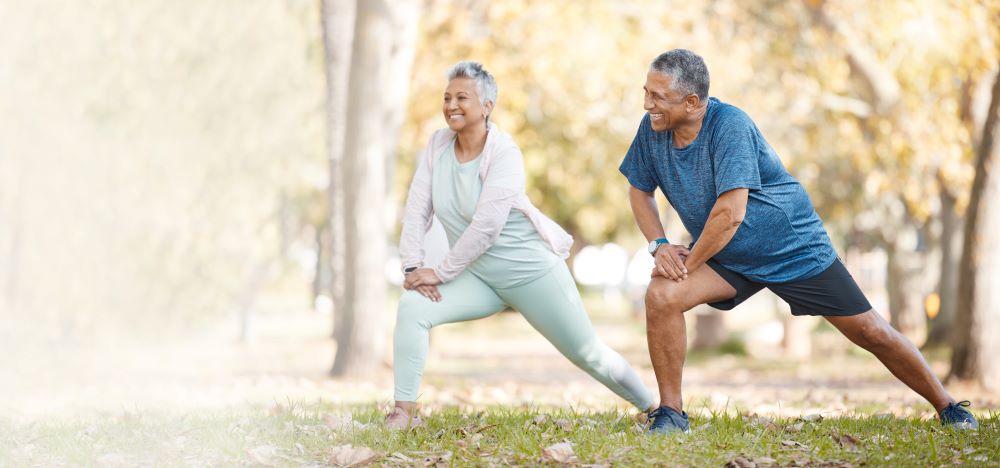Understanding the Importance of Stretching
Why Stretching is Crucial
Stretching is an essential part of any physical activity, including running. It helps to prepare the muscles for the exercise and reduces the risk of injury. When the muscles are not warmed up, they are more prone to tears and strains—stretching aids in increasing the blood flow to the muscles, making them less prone to injury and more flexible.
Stretching before running can also improve performance. It helps increase the range of motion of the joints, leading to better running form and a more efficient stride. It also helps to reduce muscle soreness after the run.
Types of Stretching
The two most basic types of stretching are static and dynamic. Static stretching is when you hold a stretch for some time, usually between 10 and 30 seconds. Dynamic stretching involves moving the muscles through a range of motion, such as arm swings or walking lunges.
Static stretching is best done after a run or workout when the muscles are warm. It helps to improve flexibility and reduce muscle soreness. Dynamic stretching is best done before a run or workout, as it helps warm the muscles and prepare them for the activity.
It is important to note that stretching should never be painful. If a stretch is causing pain, stop immediately. Stretching all major muscle groups, including the hamstrings, quadriceps, calves, and hips, is also important.
In conclusion, stretching is crucial to any physical activity, including running. It helps to prepare the muscles for the activity and reduce the risk of injury. Static stretching is best done after a run or workout, while dynamic stretching is best done before.
Stretching Before Running
Stretching before running has long been a common practice among runners. It is believed that stretching before running can help prevent injury and improve performance. However, recent studies have shown conflicting evidence on whether stretching before running is beneficial. This section will explore the benefits and potential risks of pre-run stretching.
Benefits of Pre-Run Stretching
Stretching before running can have several benefits, including:
- Improved flexibility: Stretching before running can help improve the range of motion and flexibility, which can help prevent injury.
- Increased blood flow: Stretching can increase blood flow to the muscles, which can help prepare them for exercise.
- Enhanced performance: Some studies suggest that stretching before running can improve performance by enhancing muscle activation and reducing muscle fatigue.
Potential Risks of Pre-Run Stretching
While there are benefits to stretching before running, there are also potential risks, including:
- Decreased muscle strength: Some studies have shown that stretching before exercise can decrease muscle strength and power, negatively affecting performance.
- Increased risk of injury: Stretching before running can increase the risk of injury if not done properly. Overstretching or stretching cold muscles can cause strains or sprains.
- Delayed onset muscle soreness (DOMS): Stretching before running can cause DOMS, which is muscle soreness that occurs 24-48 hours after exercise.
Overall, the benefits and risks of pre-run stretching depend on the individual and their specific needs. It is important to warm up properly before stretching and to stretch gently and slowly. If you have any pain or discomfort while you stretch, stop immediately and consult with a healthcare professional.
Stretching After Running
Stretching after running is another option for runners who want to increase their flexibility and reduce the risk of injury. This section will explore the advantages and possible drawbacks of post-run stretching.
Advantages of Post-Run Stretching
Stretching after running can have several benefits for runners. Here are a few advantages:
- Improved flexibility: Stretching after running can improve flexibility by increasing the range of motion in the joints. This can help runners perform better and reduce the risk of injury.
- Reduced muscle soreness: Stretching after running helps reduce muscle soreness by increasing muscle blood flow and reducing lactic acid buildup.
- Relaxation: Stretching after running can help promote relaxation and reduce stress levels. This can be beneficial for runners who experience stress-related injuries.
Possible Drawbacks of Post-Run Stretching
While stretching after running can have several benefits, there are also some possible drawbacks. Here are a few possible drawbacks:
- Increased risk of injury: Stretching after running can increase the risk of injury if the stretches are not done correctly, or the muscles are too tired. It’s important to avoid overstretching and to listen to your body.
- Decreased performance: Stretching after running can decrease performance if the stretches are too intense or if they are done for too long. It’s important to find a balance between stretching and recovery.
- Time-consuming: Stretching after running can be time-consuming, especially if the stretches are done for a long period. This can be challenging for runners who have busy schedules.
Overall, stretching after running can be beneficial for reducing the risk of injury and increasing flexibility. However, it’s important to approach post-run stretching cautiously and find a balance between stretching and recovery.
Comparing Pre-Run and Post-Run Stretching
Stretching is an essential part of any exercise routine, especially running. It helps to loosen up the muscles and prevent injury. But the question remains, is it better to stretch before or after running? In this section, we will compare pre-run and post-run stretching and their benefits.
Pre-Run Stretching
 Pre-run stretching involves stretching before starting your running routine. It is believed to help warm the muscles and prepare them for the upcoming exercise. Here are some benefits of pre-run stretching:
Pre-run stretching involves stretching before starting your running routine. It is believed to help warm the muscles and prepare them for the upcoming exercise. Here are some benefits of pre-run stretching:
- Helps to increase flexibility and range of motion
- Reduces running related injury by preparing the muscles and joints
- Increases blood flow to the muscles, reducing muscle soreness
However, it is essential to note that pre-run stretching should not be done excessively. Overstretching before a run can lead to injury and decreased performance.
Post-Run Stretching
Post-run stretching involves stretching after completing your running routine. It is believed to help cool down the muscles and prevent injury. Here are some benefits of post-run stretching:
- Helps to reduce muscle soreness and stiffness
- Increases flexibility and range of motion
- Helps to prevent injury by reducing muscle tension
Post-run stretching should be done gently and gradually. Overstretching after a run can also lead to injury and decreased performance.
In conclusion, both pre-run and post-run stretching have their benefits. It depends on the individual’s preference and what works best for their body. Listening to your body and stretching safely is important to prevent injury.
Expert Opinions on Stretching and Running
There are varying opinions on whether it is better to stretch before or after running. Some experts believe that stretching before running can help prevent injuries, while others argue that stretching after running is more effective.
According to Dr. Jordan Metzl, a sports medicine physician at the Hospital for Special Surgery in New York City, stretching before running can help increase flexibility and range of motion, reducing the risk of injury. However, he recommends dynamic stretching, which involves moving the joints through a full range of motion, rather than static stretching, which involves holding a stretch for a prolonged period of time.
On the other hand, Dr. Reed Ferber, director of the Running Injury Clinic at the University of Calgary, argues that stretching before running may actually increase the risk of injury. He believes that static stretching can temporarily weaken the muscles and reduce their ability to absorb shock, which can lead to injury during exercise.
Both experts agree that stretching after running is important for improving flexibility and reducing muscle soreness. Dr. Metzl recommends a combination of static and dynamic stretching, as well as foam rolling and other forms of self-massage. Dr. Ferber suggests using a foam roller or other self-massage tool to target specific muscle groups that may be tight or sore.
Ultimately, the decision of whether to stretch before or after running may depend on individual preferences and needs. It is important to listen to your body and consult with a healthcare professional if you have any concerns about your stretching routine.
Practical Tips for Stretching and Running
When it comes to stretching and running, there are a few practical tips that can help runners get the most out of their workouts. Here are some tips to keep in mind:
1. Warm-up before stretching
Before stretching, it’s important to warm up your muscles. This can be done through light jogging or walking. A warm-up helps to increase blood flow to your muscles, making them more pliable and less prone to injury.
2. Stretch after your workout
Stretching after your workout can help to reduce muscle soreness and stiffness. It’s best to hold each stretch for 15 to 30 seconds, and repeat each stretch two to four times.
3. Focus on major muscle groups
When stretching, it’s important to focus on major muscle groups such as the hamstrings, quadriceps, and calves. These muscles are used most during running and can become tight and prone to injury.
4. Use dynamic stretching
Dynamic stretching involves a range of motion that helps to improve flexibility and range of motion. Examples of dynamic stretches include squats and leg swings.
5. Don’t overdo it
It’s important to listen to your body and not overdo it when stretching. Stretching should feel comfortable and not painful. If you experience pain, stop stretching and consult a healthcare professional.
By following these practical tips for stretching and running, runners can improve their flexibility, reduce the risk of injury, and get the most out of their workouts.


